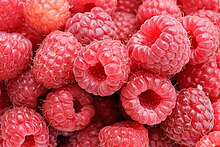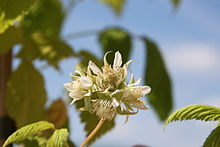
Fruit of four species of raspberry. Clockwise from top left: Boulder raspberry, Korean raspberry, Australian native raspberry, West Indian raspberry
Contents |
Species
Examples of raspberry species in subgenus Idaeobatus include:- Rubus crataegifolius (Korean raspberry)
- Rubus idaeus (European red raspberry)
- Rubus leucodermis (Whitebark or Western raspberry, Blue raspberry, Black raspberry)
- Rubus occidentalis (Black raspberry)
- Rubus parvifolius (Australian native raspberry)
- Rubus phoenicolasius (Wine raspberry or Wineberry)
- Rubus rosifolius (West Indian raspberry)
- Rubus strigosus (American red raspberry) (syn. R. idaeus var. strigosus)
- Rubus arcticus (Arctic raspberry, subgenus Cyclactis)
- Rubus deliciosus (Boulder raspberry, subgenus Anoplobatus)
- Rubus nivalis (Snow raspberry, subgenus Chamaebatus)
- Rubus odoratus (Flowering raspberry, subgenus Anoplobatus)
- Rubus sieboldii (Molucca raspberry, subgenus Malachobatus)
Cultivation
| Output in Tons, 2003-2004: FAOSTAT (FAO) | |||||
| 95000 | 26 % | 110000 | 28 % | ||
| 79471 | 21 % | 79180 | 20 % | ||
| 48535 | 13 % | 50000 | 13 % | ||
| 42941 | 12 % | 42000 | 11 % | ||
| 20600 | 6 % | 20500 | 5 % | ||
| 19700 | 5 % | 20000 | 5 % | ||
| 14236 | 4 % | 13700 | 4 % | ||
| 9000 | 2 % | 10000 | 3 % | ||
| 8000 | 2 % | 8000 | 2 % | ||
| 6830 | 2 % | 7500 | 2 % | ||
| The Rest | 27603 | 7 % | 27890 | 7 % | |
| Total | 371916 | 100 % | 389061 | 100 % | |
Two types of most commercially grown kinds of raspberry are available, the summer-bearing type that produces an abundance of fruit on second-year canes (floricanes) within a relatively short period in mid-summer, and double- or "ever"-bearing plants, which also bear some fruit on first-year canes (primocanes) in the late summer and fall, as well as the summer crop on second-year canes. Raspberries can be cultivated from hardiness zones 3 to 9.
Raspberries are traditionally planted in the winter as dormant canes, although planting of tender, plug plants produced by tissue culture has become much more common. A specialized production system called "long cane production" involves growing canes for 1 year in a northern climate such as Scotland (UK) or Washington State (US) where the chilling requirement for proper budbreak is met early. These canes are then dug, roots and all, to be replanted in warmer climates such as Spain where they quickly flower and produce a very early season crop. Plants should be spaced 1 m apart in fertile, well drained soil; raspberries are usually planted in raised beds/ridges if there is any question about root rot problems.
The flowers can be a major nectar source for honeybees and other pollinators.
Raspberries are very vigorous and can be locally invasive. They propagate using basal shoots (also known as suckers); extended underground shoots that develop roots and individual plants. They can sucker new canes some distance from the main plant. For this reason, raspberries spread well, and can take over gardens if left unchecked.
The fruit is harvested when it comes off the torus/receptacle easily and has turned a deep color (red, black, purple, or golden yellow, depending on the species and cultivar). This is when the fruits are ripest and sweetest. Excess fruit can be made into raspberry jam or frozen.
The leaves can be used fresh or dried in herbal and medicinal teas. They have an astringent flavour, and in herbal medicine are reputed to be effective in regulating menses.
An individual raspberry weighs about 4 g, on average[2] and is made up of around 100 drupelets,[3] each of which consists of a juicy pulp and a single central seed. Raspberry bushes can yield several hundred berries a year. Unlike blackberries and dewberries, a raspberry has a hollow core once it is removed from the receptacle.
Cultivars
Numerous raspberry cultivars have been selected. Recent breeding has resulted in cultivars that are thornless and more strongly upright, not needing staking.Red raspberries (Rubus idaeus and/or Rubus strigosus) have been crossed with the black raspberry (Rubus occidentalis) to produce purple raspberries, and with various species in other subgenera of the genus Rubus, resulting in a number of hybrids, such as boysenberry and loganberry. Hybridization between the familiar cultivated raspberries and a few Asiatic species of Rubus is also being explored.
Selected important cultivars
Source: New RHS Dictionary of Gardening.[4]
|
|
Diseases and pests
| This section requires expansion. |
Raspberry plants should not be planted where potatoes, tomatoes, peppers, eggplants or bulbs have previously been grown, without prior fumigation of the soil. These crops are hosts for the disease Verticillium Wilt, a fungus that can stay in the soil for many years and can infest the raspberry crop.[5]
Commerce
Raspberries are an important commercial fruit crop, widely grown in all temperate regions of the world. Many of the most important modern commercial red raspberry cultivars derive from hybrids between R. idaeus and R. strigosus.[4] Some botanists consider the Eurasian and American red raspberries to all belong to a single, circumboreal species, Rubus idaeus, with the European plants then classified as either R. idaeus subsp. idaeus or R. idaeus var. idaeus, and the native North American red raspberries classified as either R. idaeus subsp. strigosus, or R. idaeus var. strigosus.The black raspberry, Rubus occidentalis, is also occasionally cultivated in the United States, providing both fresh and frozen fruit as well as jams, preserves, and other products, all with that species' distinctive, richer flavor.
Purple-fruited raspberries have been produced by horticultural hybridization of red and black raspberries, and have also been found in the wild in a few places (for example, in Vermont) where the American red and the black raspberries both grow naturally. The unofficial name Rubus × neglectus has been applied to these native American plants for which commercial production is rare.
Red and black raspberry species have albino-like pale-yellow variants resulting from expression of recessive genes for anthocyanin pigments. Variously called golden raspberries, yellow or (rarely) orange raspberries retain the distinctive flavor of their respective species. In the eastern United States, most commercially sold pale-fruited raspberries are derivatives of red raspberries. Yellow-fruited variants of the black raspberry occur occasionally in the wild or are grown in home gardens.
| This section requires expansion. |
Nutrients and health benefits
| Nutritional value per 100 g (3.5 oz) | |
|---|---|
| Energy | 263.592 kJ (63.000 kcal) |
| Carbohydrates | 14.7 g |
| Sugars | 5.4 g |
| Dietary fiber | 8 g |
| Fat | .8 g |
| saturated | 0 g |
| monounsaturated | .1 g |
| polyunsaturated | .5 g |
| Protein | 1.5 g |
| Vitamin A equiv. | 1 μg (0%) |
| - beta-carotene | 120 μg (1%) |
| Vitamin C | 54 mg (90%) |
| Calcium | 3 mg (0%) |
| Iron | 5 mg (40%) |
| Sodium | 1 mg (0%) |
| Percentages are relative to US recommendations for adults. Source: USDA Nutrient database | |
Raspberries rank near the top of all fruits for antioxidant strength, particularly due to their dense contents of ellagic acid (from ellagotannins), quercetin, gallic acid, anthocyanins, cyanidins, pelargonidins, catechins, kaempferol and salicylic acid. Yellow raspberries and others with pale-colored fruits are lower in anthocyanins.
Due to their rich contents of antioxidant vitamin C and the polyphenols mentioned above, raspberries have an ORAC value (oxygen radical absorbance capacity) of about 4900 per 100 grams, including them among the top-ranked ORAC fruits. Cranberries and wild blueberries have around 9000 ORAC units and apples average 2800.[8]
Although there are no clinical studies to date proving these effects in humans, antioxidant and antiproliferative (chemopreventive) effects against cancer have been linked to the amount of phenolics and flavonoids in various foods including raspberries.[9][10][11]






No comments:
Post a Comment